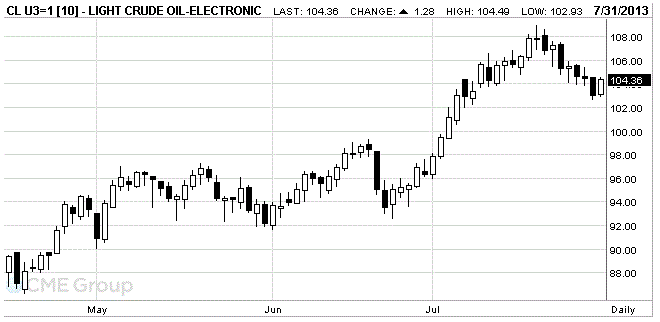Notícias do Mercado
-
16:41
Oil: an overview of the market situation
Oil prices have risen markedly, which has helped to publish a report on oil stocks in the United States. Note that the report submitted by the Energy Information Administration showed that by the end of last week, oil stocks rose by 431,000 barrels, while reaching a level of 364.622 million barrels. Many experts expected that the stock decline by 2.45 million barrels. In addition, it was reported U.S. gasoline inventories increased by 0.77 million barrels - up to 223.464 million barrels, while distillate stocks, which include heating oil and diesel, fell 0.466 million barrels to 125.986 million. We also add that the oil terminal in Cushing fell by 1,904 million - up to 42.119 million barrels and refinery utilization in the United States amounted to 91.3% against 92.3% a week earlier.
We also recall that yesterday its report on oil stocks posted the American Petroleum Institute. According to them, the oil reserves fell by 0.74 million barrels, gasoline inventories rose by 1.8 million barrels, while distillate stocks fell 0.497 million barrels.
It should also be noted that the rise in oil prices helped the data on the growth of the American economy.
According to the report, the U.S. GDP in the 2nd quarter was more than expected at moderate overall growth, as consumers are not willing to spend more, and the government continues to reduce costs.
According to the first estimate, provided by the Ministry of Commerce, U.S. gross domestic product in the 2nd quarter was higher by 1.7% per year, after rising by 1.1% in Q1. Economists had expected an increase of 1.1%.
The focus is now the second half of the year.
Note also that the Fed will announce today the results of a two-day meeting, and their intentions regarding the program of bond purchases by 85 billion dollars a month. Purchases are designed to help lower interest rates and stimulate spending and investment. The Fed has signaled that can minimize the program to begin this year, if the growth rate is improving in line with its forecasts. GDP report allows the Fed to turn around and evaluate the performance of the economy after the recession. Extensive changes to the data show that the U.S. economy expanded at a strong pace in 2012, but the decline was not as strong as previously thought. GDP last year increased by 2.8% compared with the rate in the previous assessment + 2.2%. Changes occur as part of a comprehensive revision of the gross domestic product from 1929 to the first quarter of 2013.
The cost of the September futures on U.S. light crude oil WTI (Light Sweet Crude Oil) rose to 104.36 dollars a barrel on the New York Mercantile Exchange.
September futures price for North Sea Brent crude oil mixture increased to $ 107.00 a barrel on the London exchange ICE Futures Europe.

-
16:21
Gold: an overview of the market situation
Gold prices fell sharply, losing what was about 1%, after previously presented strong data on the U.S. dollar strengthened. It should be noted that, despite this decline, the precious metal continued to exhibit the largest monthly gain since January 2012 - at the level of 5%, the first monthly increase since March, that, first of all, was associated with a statement from Fed Chairman Ben Bernanke that a highly accommodative monetary policy will be needed for the foreseeable future, and that any reduction in bond purchases will depend on the state of the economy.
Note that today's report from the Commerce Department showed that economic activity in the United States increased at a faster pace than expected in the second quarter. At the same time, the report also shows a significant downward revision to growth in the first quarter.
According to the report, the gross domestic product increased by 1.7 percent in the second quarter, following a revised 1.1 percent increase in the first quarter. Economists had expected GDP to grow by 1.1 percent compared with 1.8 percent growth, which have been registered in the previous quarter. Real final sales in the U.S. in Q2 rose by 1.3%. The price index for personal consumption expenditures (PCE) in the 2nd quarter unchanged. The basic price index for personal consumption expenditures (Core PCE) in the 2nd quarter +0.8%.
Meanwhile, today it was reported that employment in the private sector in the U.S. has increased more than expected in July. ADP reported that private sector employment increased by 200,000 jobs in July after an upwardly revised increase of 198,000 jobs in June. Economists had expected employment to increase by about 179,000 jobs compared to the addition of 188,000 jobs, which was originally reported in the previous month.
Note that the data presented by the strong increase the likelihood that the Fed is getting closer to reducing its incentives. Many market participants now expect the Federal Reserve, which is expected to help shed light on the possible purchase of bonds.
The cost of the August gold futures on COMEX today dropped to $ 1309.10 per ounce.

-
06:21
Commodities. Daily history for Jul 30’2013:
Change % Change Last
GOLD 1,325.20 -3.20 -0.24%
OIL (WTI) 103.10 -1.45 -1.39%
-